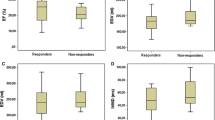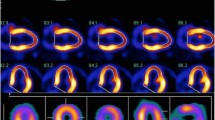Abstract
Background
Myocardial lipid metabolism appears abnormal in dilated cardiomyopathy (DCM). A dual-tracer approach with two different fatty acid analogs may allow us to observe such alteration in vivo. 15-(Ortho-123I-phenyl)-pentadecanoic acid (oPPA) and 15-(para-123I-phenyl)-pentadecanoic acid (pPPA) have similar kinetics in circulation, diffusion, and transport. However, pPPA in normal myocardium undergoes β-oxidation and may also be lost from myocardial cells through back-diffusion; oPPA is hardly catabolized and normally retained mainly in the cytosolic lipid pool. Use of both pPPA and oPPA in the dual-tracer approach focuses observation on the turnover of myocardial lipids (with pPPA) that is scaled against loss of fatty acid through back-diffusion into circulation (with oPPA).
Methods and Results
Fifteen patients with idiopathic DCM and five control subjects were given oPPA and pPPA sequentially for dynamic planar scintigraphy. Uptake and elimination rates were determined for both substrates from three myocardial regions per individual; the corresponding six elimination rate constants and the three differences between them were analyzed for significant alterations in patients from control values. At least 66% of the patients had a significant alteration in myocardial lipid turnover in three types of patterns: (1) increased β-oxidation, (2) decreased β-oxidation, and (3) increased back-diffusion, in part associated with decreased β-oxidation. Even with the limited number of patients and control subjects, the pattern of abnormality of lipid turnover in DMC appeared to be consistent individually but heterogeneous in the patient group. Moreover, a highly significant increase in β-oxidation was observed for the posterolateral region of the myocardium compared with the anteroseptal and apical regions in control subjects and patients.
Conclusion
The dual-tracer approach uncovered in vivo that in at least two thirds of the patients with DCM myocardial lipid turnover was significantly altered compared with control values.
Similar content being viewed by others
References
Shabetai R. Cardiomyopathy: how far have we come in 25 years, how far yet to go? J Am Coll Cardiol 1983;1:252–63.
Eisenberg JD, Sobel BE, Geltman EM. Differentiation of ischemic from nonischemic cardiomyopathy with positron emission tomography. Am J Cardiol 1987;59:1410–4.
Geltman EM, Smith JL, Beecher D, Ludbrook PA, Ter-Pogossian MM, Sobel BE. Altered regional myocardial metabolism in congestive cardiomyopathy detected by positron tomography. Am J Med 1983;74:733–85.
Höck A, Freundlieb C, Vyska K, Lösse B, Erbel R, Feinendegen LE. Myocardial imaging and metabolic studies with 17-I-123-iodoheptadecanoic acid in patients with idiopathic congestive cardiomyopathy. J Nucl Med 1984;24:22–8.
Ugolini V, Hansen CL, Kulkarni PV, Jansen DE, Akers MS, Corbett JR. Abnormal myocardial fatty acid metabolism in dilated cardiomyopathy detected by iodine-123-phenylpenta-decanoic acid and tomographic imaging. Am J Cardiol 1988;62:923–8.
Höck A, Notohamiprodjo G, Spohr G, et al. Myocardial fatty acid metabolism after acute ethanol consumption. Nucl Med Commun 1986;7:671–82.
Notohamiprodjo G, Schmid A, Spohr G, Herzog H, Feinendegen LE. Comparison of myocardial metabolism of 11-C-palmitic acid (11-CPA) and 123-I-heptadecanoic acid (123-IHA) in man. In: Schmidt HAE, Vauramo DE, Schattaeur FK, eds. Nuklearmedizin: Nuklearmedizin in Forschung und Paxis. New York: Stuttgart, 1984;233–6.
Wieler H, Kaiser KP, Kuikka JT, Henkel B, Frank J, Landwein K. Standardized noninvasive assessment of myocardial free fatty acid kinetics by mean of 15-(p-iodo-phenyl) pentadecanoic acid (123-I-pPPA) scintigraphy, II: clinical results. Nucl Med Commun 1992;13:168–85.
Henrich MM, Goßmann K, Motz W, et al. Beta-oxidation of 1-[14C]-17-[131I]-iodoheptadecanoic acid in the human myocardium causes parallel release of both tracers. Eur J Nucl Med 1993;6:225–30.
Kuikka JT, Levin M, Bassingthwaighte JB. Multiple tracer dilution estimates of D- and 2-deoxy-D-glucose uptake of the heart. Am J Physiol 1986;250:H29–42.
Feinendegen LE, Vyska K, Freundlieb C, et al. Non-invasive analysis of metabolic reactions in body tissues: the case of myocardial fatty acids. Eur J Nucl Med 1981;6:191–200.
Feinendegen LE. The dual parameter analysis for in vivo measuring metabolic reactions. In: Höfer R, Bergman H, eds. Radioaktive Isotope in Klinik und Forschung. Vienna: Egermann, 1984:465–86.
Beckurts TE, Shreeve WW, Schieren R, Feinendegen LE. Kinetics of different 123-I and 14-C-labelled fatty acids in normal and diabetic rat myocardium in vivo. Nucl Med Commun 1985;6:415–25.
Antar MA, Spohr G, Herzog H, et al. 15-(Ortho-123-I-phenyl)-pentadecanoic acid: a new myocardial imaging agent for clinical use. Nucl Med Commun 1986;7:683–96.
Kaiser KP, Geuting B, Großmann K, et al. Tracer kinetics of 15-(ortho-123/131-I-phenyl)-pentadecanoic acid (oPPA) and 15-(para-123/131-I-phenyl)-pentadecanoic acid (pPPA) in animals and man. J Nucl Med 1990;31:1608–16.
Daus HJ, Reske SN, Machulla HJ, Massmann P, Dutschka D, van Beuningen D. Omega-P-131-I-phenylpentadecanoic acid, a highly promising radioiodinated fatty acid for myocardial imaging studies, II: biodistribution in mice and rabbits. In: Höfer R, Bergmann H, eds. Radioaktive Isotope in Klinik und Forschung. Vienna: H Egermann, 1980:369–76.
Reske SN. 123-I-phenylpentadecanoic acid as a tracer of cardiac free fatty acid metabolism: experimental and clinical results. Eur Heart J 1985;6(suppl):39–47.
Duwel CMB, Visser FC, Eenige MJ, Roos JP. Variable of myocardial back diffusion determined with 17-iodo-131 heptadecanoic acid in normal dog heart. Mol Cell Biochem 1989;88:191–4.
Freundlieb C, Höck A, Vyska K, Feinendegen LE, Machulla HJ, Stöcklin G. Myocardial imaging and metabolic studies with 17-I-123-iodoheptadecanoic acid. J Nucl Med 1980; 21:1043–50.
Dudczak R. Myokardszintigraphie mit Jod-123-markierten Fettsäuren. Klin Wochenschr 1983;65(suppl):1–35.
Reske SN, Schön S, Knust EJ, et al. Relation of myocardial blood flow and initial cardiac uptake of 15-(p-123I-phenyl)-pentadecanoic acid in the canine heart. Nucl Med 1986;23:83–5.
Wolfe CL, Kennedy PL, Kulkarni PV, Jansen DE, Gabliani GI, Corbett JR. Iodine-123-phenylpentadecanoic acid myocardial scintigraphy in patients with left ventricular hypertrophy: alterations in left ventricular distribution and utilization. Am Heart J 1990;119:1338–47.
Author information
Authors and Affiliations
Rights and permissions
About this article
Cite this article
Feinendegen, L.E., Henrich, M.M., Kuikka, J.T. et al. Myocardial lipid turnover in dilated cardiomyopathy: A dual in vivo tracer approach. J Nucl Cardiol 2, 42–52 (1995). https://doi.org/10.1016/S1071-3581(05)80007-8
Received:
Accepted:
Issue Date:
DOI: https://doi.org/10.1016/S1071-3581(05)80007-8




